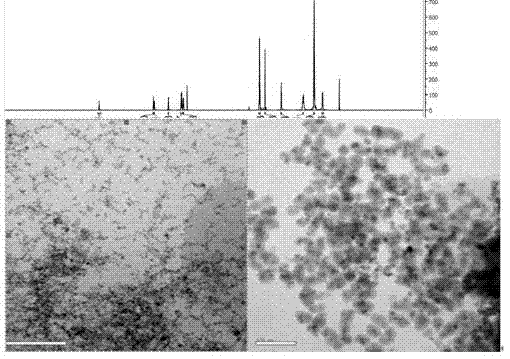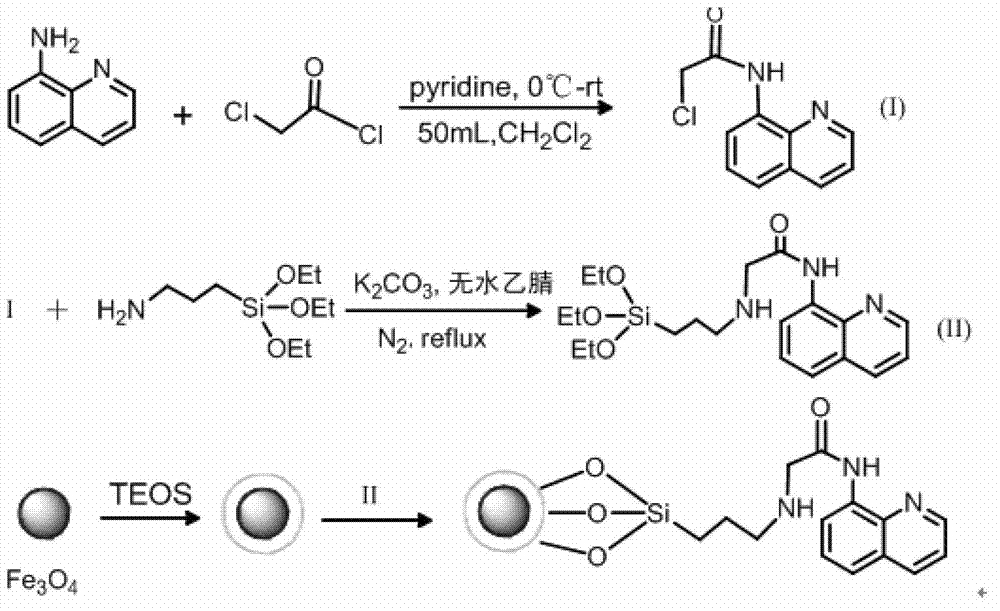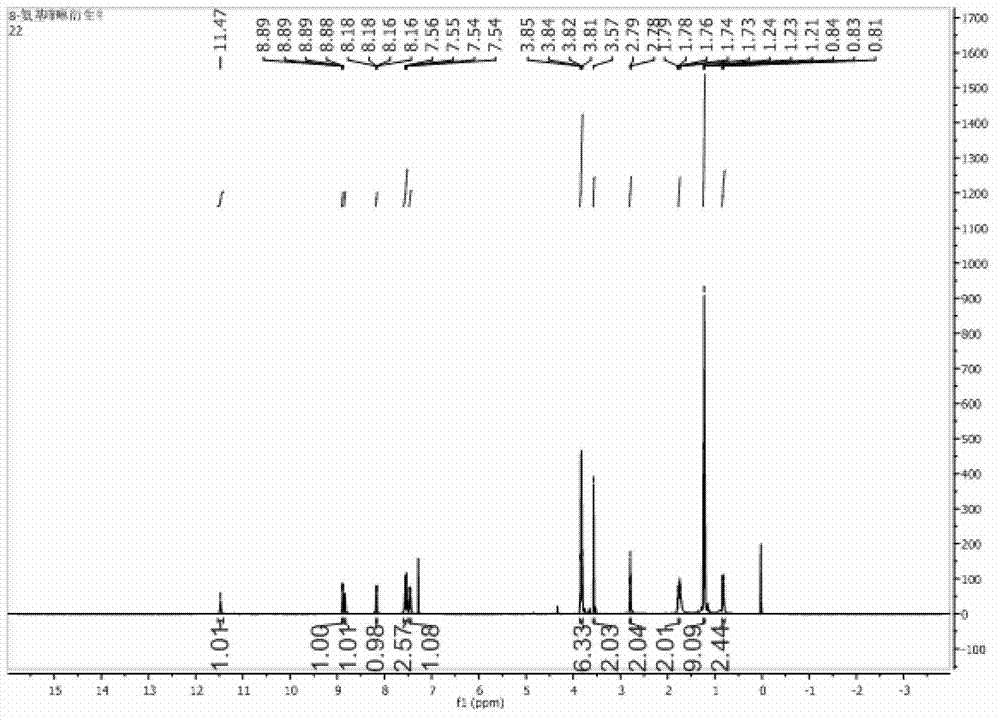Method for preparing fluorescent and magnetic resonance dual-functional nanometer super-paramagnetic particles for detecting life system
A dual-function, superparamagnetic technology, which is applied in the field of preparation of nano-superparamagnetic particles, can solve the problems of poor water solubility, low quantum yield, and high viscosity of inorganic light-emitting quantum dots, so as to facilitate separation, enhance sensitivity, eliminate apply limited effects
- Summary
- Abstract
- Description
- Claims
- Application Information
AI Technical Summary
Problems solved by technology
Method used
Image
Examples
Embodiment 1
[0026] (1) Step 1: Magnetic nanoparticles Fe 3 o 4 preparation of
[0027] 270mg ferric chloride hexahydrate (FeCl 3 ·6H 2 O, 1mmol), 99.4mg ferrous chloride tetrahydrate (FeCl 2 4H 2 O, 99.4mg, 0.5mmol) and 20g of ethylene glycol (DEG) were sequentially added to the nitrogen-protected three-necked flask, and 160mg (4mmol) of NaOH dissolved in 10g of diethylene glycol was added to the above-mentioned three-necked flask. The mixed solution was heated to 190-210°C for two hours, stopped heating, and cooled to room temperature. The product was separated by an external magnetic field, and washed six times with ethanol and secondary water to remove excess DEG and other substances. Finally, the product was dispersed in 10 mL of secondary water for use.
[0028] (2) Step 2: "I" is the synthesis of 8-[(chloroacetyl)amino]quinoline (I)
[0029] 1.15g (8mmol) of 8-aminoquinoline and 1.25g (11.2mmol), 2-chloroacetyl chloride and 890mg of pyridine (11.2mmol) were sequentially added...
Embodiment 2
[0035] (1) Step 1: Preparation of magnetic nanoparticles Fe3O4
[0036] 270mg ferric chloride hexahydrate (FeCl 3 ·6H 2 O, 1mmol), 99.4mg ferrous chloride tetrahydrate (FeCl 2 4H 2 O, 99.4mg, 0.5mmol) and 20g of ethylene glycol (DEG) were sequentially added to the nitrogen-protected three-necked flask, and 160mg (4mmol) of NaOH dissolved in 10g of diethylene glycol was added to the above-mentioned three-necked flask. The mixed solution was heated to 190°C for two hours, stopped heating, and cooled to room temperature. The product was separated by an external magnetic field, and washed six times with ethanol and secondary water to remove excess DEG and other substances. Finally, the product was dispersed in 10 mL of secondary water for use.
[0037] (2) Step 2: "I" is the synthesis of 8-[(chloroacetyl)amino]quinoline (I)
[0038] 1.15g (8mmol) of 8-aminoquinoline and 1.25g (11.2mmol), 2-chloroacetyl chloride and 890mg of pyridine (11.2mmol) were sequentially added to 50mL ...
Embodiment 3
[0044] (1) Step 1: Magnetic nanoparticles Fe 3 o 4 preparation of
[0045] 270mg ferric chloride hexahydrate (FeCl 3 ·6H 2 O, 1mmol), 99.4mg ferrous chloride tetrahydrate (FeCl 2 4H 2 O, 99.4mg, 0.5mmol) and 20g of ethylene glycol (DEG) were sequentially added to the nitrogen-protected three-necked flask, and 160mg (4mmol) of NaOH dissolved in 10g of diethylene glycol was added to the above-mentioned three-necked flask. The mixed solution was heated to 190-210°C for two hours, stopped heating, cooled to room temperature, the product was separated by an external magnetic field, and washed six times with ethanol and secondary water to remove excess DEG and other substances. Finally, the product was dispersed in 10 mL of secondary water for use.
[0046] (2) Step 2: "I" is the synthesis of 8-[(chloroacetyl)amino]quinoline (I)
[0047] 1.15g (8mmol) of 8-aminoquinoline and 1.25g (11.2mmol), 2-chloroacetyl chloride and 890mg of pyridine (11.2mmol) were sequentially added to ...
PUM
 Login to View More
Login to View More Abstract
Description
Claims
Application Information
 Login to View More
Login to View More - R&D
- Intellectual Property
- Life Sciences
- Materials
- Tech Scout
- Unparalleled Data Quality
- Higher Quality Content
- 60% Fewer Hallucinations
Browse by: Latest US Patents, China's latest patents, Technical Efficacy Thesaurus, Application Domain, Technology Topic, Popular Technical Reports.
© 2025 PatSnap. All rights reserved.Legal|Privacy policy|Modern Slavery Act Transparency Statement|Sitemap|About US| Contact US: help@patsnap.com



